64 Cores of Rendering Madness: The AMD Threadripper Pro 3995WX Review
by Dr. Ian Cutress on February 9, 2021 9:00 AM EST- Posted in
- CPUs
- AMD
- Lenovo
- ThinkStation
- Threadripper Pro
- WRX80
- 3995WX
CPU Tests: Office and Science
Our previous set of ‘office’ benchmarks have often been a mix of science and synthetics, so this time we wanted to keep our office section purely on real world performance.
Agisoft Photoscan 1.3.3: link
The concept of Photoscan is about translating many 2D images into a 3D model - so the more detailed the images, and the more you have, the better the final 3D model in both spatial accuracy and texturing accuracy. The algorithm has four stages, with some parts of the stages being single-threaded and others multi-threaded, along with some cache/memory dependency in there as well. For some of the more variable threaded workload, features such as Speed Shift and XFR will be able to take advantage of CPU stalls or downtime, giving sizeable speedups on newer microarchitectures.
For the update to version 1.3.3, the Agisoft software now supports command line operation. Agisoft provided us with a set of new images for this version of the test, and a python script to run it. We’ve modified the script slightly by changing some quality settings for the sake of the benchmark suite length, as well as adjusting how the final timing data is recorded. The python script dumps the results file in the format of our choosing. For our test we obtain the time for each stage of the benchmark, as well as the overall time.
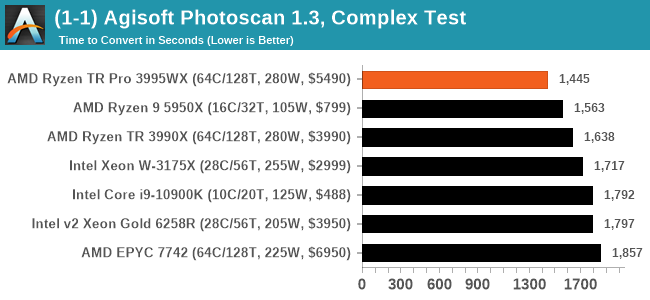
The high core count and high memory bandwidth put the wins onto AMD here, and the 3995WX is +13.3% faster compared to the standard Threadripper. The difference back to EPYC is +28.5%.
Application Opening: GIMP 2.10.18
First up is a test using a monstrous multi-layered xcf file to load GIMP. While the file is only a single ‘image’, it has so many high-quality layers embedded it was taking north of 15 seconds to open and to gain control on the mid-range notebook I was using at the time.
What we test here is the first run - normally on the first time a user loads the GIMP package from a fresh install, the system has to configure a few dozen files that remain optimized on subsequent opening. For our test we delete those configured optimized files in order to force a ‘fresh load’ each time the software in run. As it turns out, GIMP does optimizations for every CPU thread in the system, which requires that higher thread-count processors take a lot longer to run.
We measure the time taken from calling the software to be opened, and until the software hands itself back over to the OS for user control. The test is repeated for a minimum of ten minutes or at least 15 loops, whichever comes first, with the first three results discarded.
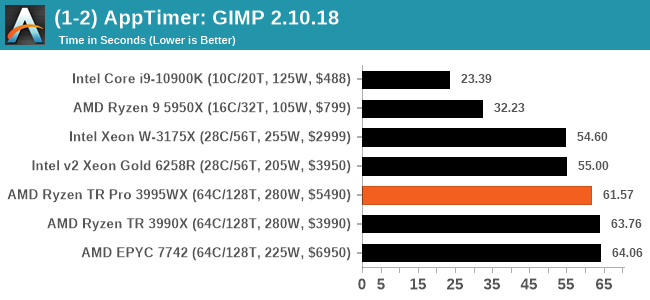
Our GIMP test here scales out with core count, so a 64C processor has 4x the work of a 16C processor. That means the smaller core-count parts take the win.
Science
In this version of our test suite, all the science focused tests that aren’t ‘simulation’ work are now in our science section. This includes Brownian Motion, calculating digits of Pi, molecular dynamics, and for the first time, we’re trialing an artificial intelligence benchmark, both inference and training, that works under Windows using python and TensorFlow. Where possible these benchmarks have been optimized with the latest in vector instructions, except for the AI test – we were told that while it uses Intel’s Math Kernel Libraries, they’re optimized more for Linux than for Windows, and so it gives an interesting result when unoptimized software is used.
3D Particle Movement v2.1: Non-AVX and AVX2/AVX512
This is the latest version of this benchmark designed to simulate semi-optimized scientific algorithms taken directly from my doctorate thesis. This involves randomly moving particles in a 3D space using a set of algorithms that define random movement. Version 2.1 improves over 2.0 by passing the main particle structs by reference rather than by value, and decreasing the amount of double->float->double recasts the compiler was adding in.
The initial version of v2.1 is a custom C++ binary of my own code, and flags are in place to allow for multiple loops of the code with a custom benchmark length. By default this version runs six times and outputs the average score to the console, which we capture with a redirection operator that writes to file.
For v2.1, we also have a fully optimized AVX2/AVX512 version, which uses intrinsics to get the best performance out of the software. This was done by a former Intel AVX-512 engineer who now works elsewhere. According to Jim Keller, there are only a couple dozen or so people who understand how to extract the best performance out of a CPU, and this guy is one of them. To keep things honest, AMD also has a copy of the code, but has not proposed any changes.
The 3DPM test is set to output millions of movements per second, rather than time to complete a fixed number of movements.
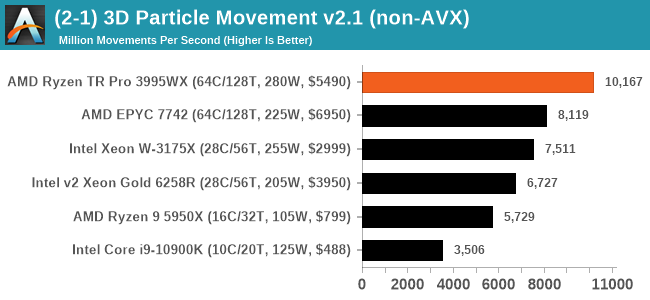
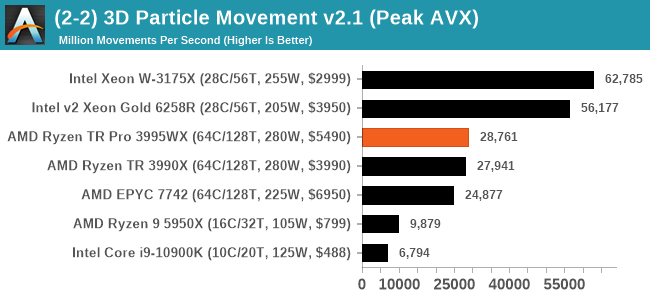
Over the EPYC 7742 we see a +15.6% in AVX mode, but a +25.2% gain in non-AVX mode. The Intel CPUs have AVX-512 which is why they sprint off in the peak AVX test.
y-Cruncher 0.78.9506: www.numberworld.org/y-cruncher
If you ask anyone what sort of computer holds the world record for calculating the most digits of pi, I can guarantee that a good portion of those answers might point to some colossus super computer built into a mountain by a super-villain. Fortunately nothing could be further from the truth – the computer with the record is a quad socket Ivy Bridge server with 300 TB of storage. The software that was run to get that was y-cruncher.
Built by Alex Yee over the last part of a decade and some more, y-Cruncher is the software of choice for calculating billions and trillions of digits of the most popular mathematical constants. The software has held the world record for Pi since August 2010, and has broken the record a total of 7 times since. It also holds records for e, the Golden Ratio, and others. According to Alex, the program runs around 500,000 lines of code, and he has multiple binaries each optimized for different families of processors, such as Zen, Ice Lake, Sky Lake, all the way back to Nehalem, using the latest SSE/AVX2/AVX512 instructions where they fit in, and then further optimized for how each core is built.
For our purposes, we’re calculating Pi, as it is more compute bound than memory bound. In single thread mode we calculate 250 million digits, while in multithreaded mode we go for 2.5 billion digits. That 2.5 billion digit value requires ~12 GB of DRAM, and so is limited to systems with at least 16 GB.
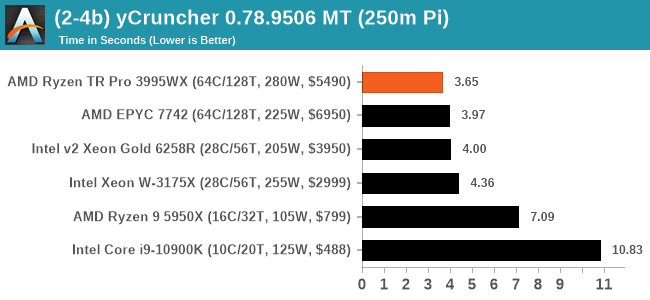
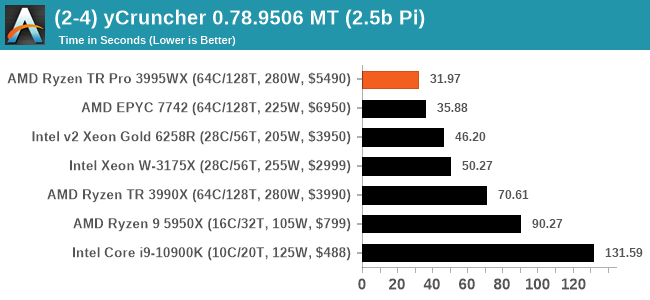
Further to the y-Cruncher sprint earlier in the review, our test here shows advantages for the systems with more memory channels as well as good mesh frequencies.
NAMD 2.13 (ApoA1): Molecular Dynamics
One of the popular science fields is modeling the dynamics of proteins. By looking at how the energy of active sites within a large protein structure over time, scientists behind the research can calculate required activation energies for potential interactions. This becomes very important in drug discovery. Molecular dynamics also plays a large role in protein folding, and in understanding what happens when proteins misfold, and what can be done to prevent it. Two of the most popular molecular dynamics packages in use today are NAMD and GROMACS.
NAMD, or Nanoscale Molecular Dynamics, has already been used in extensive Coronavirus research on the Frontier supercomputer. Typical simulations using the package are measured in how many nanoseconds per day can be calculated with the given hardware, and the ApoA1 protein (92,224 atoms) has been the standard model for molecular dynamics simulation.
Luckily the compute can home in on a typical ‘nanoseconds-per-day’ rate after only 60 seconds of simulation, however we stretch that out to 10 minutes to take a more sustained value, as by that time most turbo limits should be surpassed. The simulation itself works with 2 femtosecond timesteps. We use version 2.13 as this was the recommended version at the time of integrating this benchmark into our suite. The latest nightly builds we’re aware have started to enable support for AVX-512, however due to consistency in our benchmark suite, we are retaining with 2.13. Other software that we test with has AVX-512 acceleration.
This test also limits itself to 64 threads.
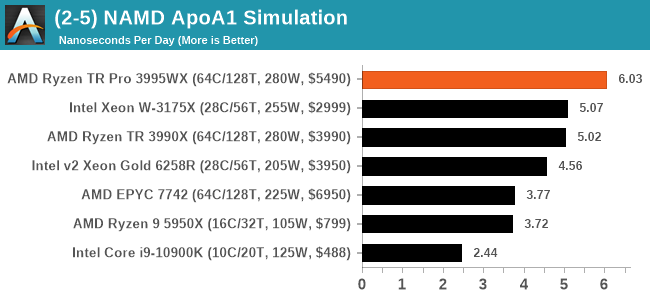
At the 64 thread limit, the 3995WX has a good +20% performance gain over the standard TR 3990X, although AMD claims a good 10 ns/day when the chip can process to its fullest.
AI Benchmark 0.1.2 using TensorFlow: Link
Finding an appropriate artificial intelligence benchmark for Windows has been a holy grail of mine for quite a while. The problem is that AI is such a fast moving, fast paced word that whatever I compute this quarter will no longer be relevant in the next, and one of the key metrics in this benchmarking suite is being able to keep data over a long period of time. We’ve had AI benchmarks on smartphones for a while, given that smartphones are a better target for AI workloads, but it also makes some sense that everything on PC is geared towards Linux as well.
Thankfully however, the good folks over at ETH Zurich in Switzerland have converted their smartphone AI benchmark into something that’s useable in Windows. It uses TensorFlow, and for our benchmark purposes we’ve locked our testing down to TensorFlow 2.10, AI Benchmark 0.1.2, while using Python 3.7.6.
The benchmark runs through 19 different networks including MobileNet-V2, ResNet-V2, VGG-19 Super-Res, NVIDIA-SPADE, PSPNet, DeepLab, Pixel-RNN, and GNMT-Translation. All the tests probe both the inference and the training at various input sizes and batch sizes, except the translation that only does inference. It measures the time taken to do a given amount of work, and spits out a value at the end.
There is one big caveat for all of this, however. Speaking with the folks over at ETH, they use Intel’s Math Kernel Libraries (MKL) for Windows, and they’re seeing some incredible drawbacks. I was told that MKL for Windows doesn’t play well with multiple threads, and as a result any Windows results are going to perform a lot worse than Linux results. On top of that, after a given number of threads (~16), MKL kind of gives up and performance drops of quite substantially.
So why test it at all? Firstly, because we need an AI benchmark, and a bad one is still better than not having one at all. Secondly, if MKL on Windows is the problem, then by publicizing the test, it might just put a boot somewhere for MKL to get fixed. To that end, we’ll stay with the benchmark as long as it remains feasible.
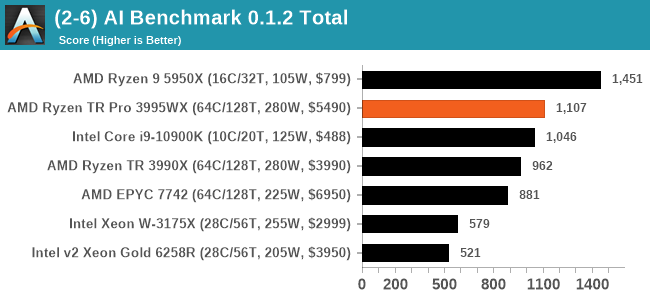


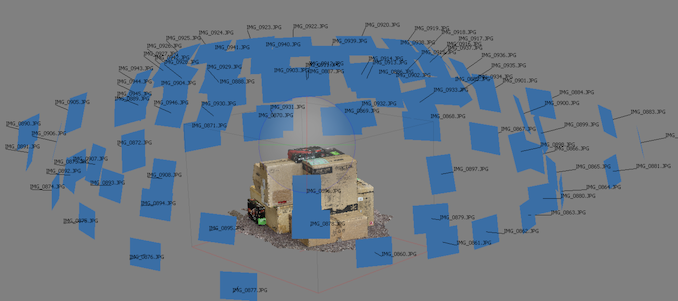

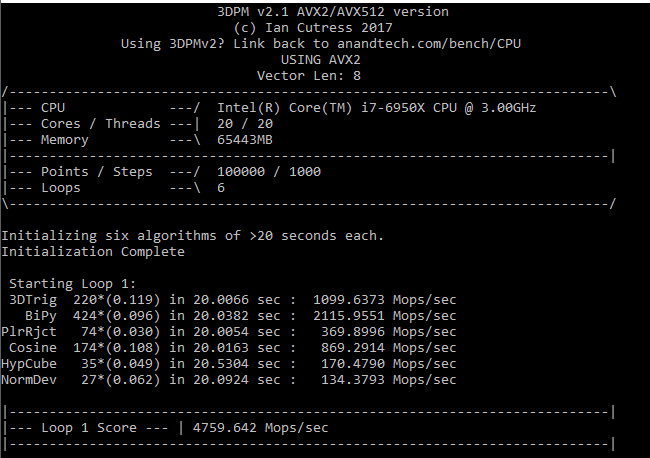
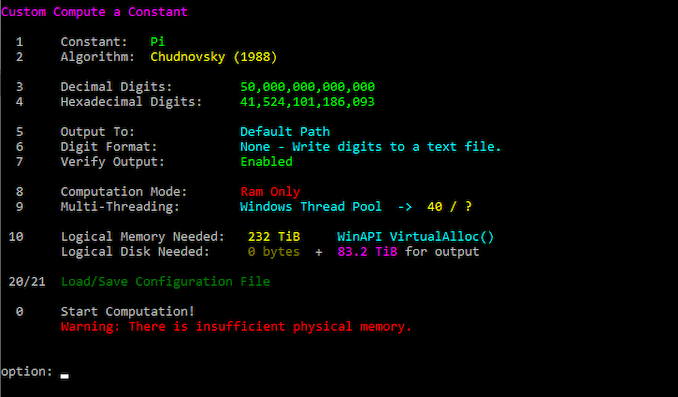
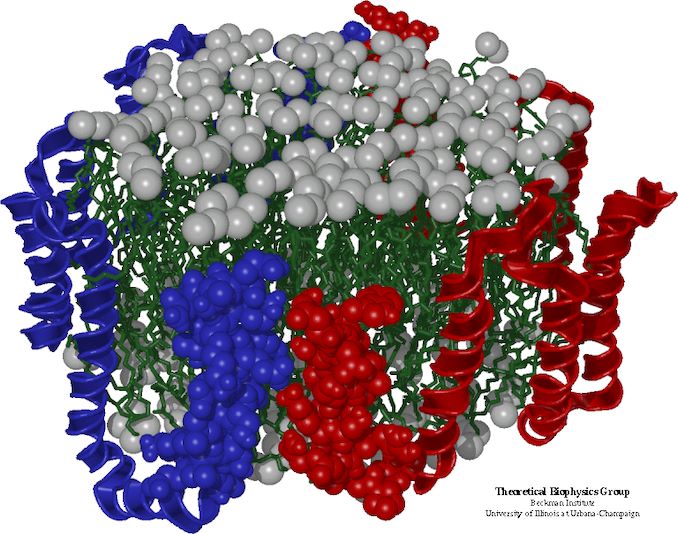









118 Comments
View All Comments
Fellovv - Tuesday, February 9, 2021 - link
Agreed— picked up a p620 with 16c for $2500, could have gotten it for lower from Lenovo if they didn’t have weeks of lead time. Ian- you may see Lenovo discounts all the crazy prices about 50% all year, and sometimes there are Honey coupons to knock off hundreds more.I have read that the 16c 2 CCX 3955WX May only get 4 channel RAM, not the full 8. I may be able to confirm in the near future. Gracias for the fine and thorough review. My only request is to ensure the TR 3990 is included in every graph— it was MIA or AWOL in several. I went with they TR Pro for the RAM and PCIe 4 lanes. Seeing the results confirms it was a good choice for me. Can’t wait for the Zen3!
realbabilu - Tuesday, February 9, 2021 - link
Nice 👍 about mkl, how about blis and open las,.did it suffer high multi core problemMonkeyMan73 - Wednesday, February 10, 2021 - link
AMD has the performance crown in most scenarios, but it comes at an extremely high price point. Might not be worth this kind of money even for most extreme power user. Maybe get a dual core Xeon? Might be cheaper.BTW, your las pic of this review is definitly not an OPPO Reno 2 :)
MonkeyMan73 - Wednesday, February 10, 2021 - link
Apologies, not a Dual core Xeon, that will not cut it but meant a Dual Socket Xeon setup.Oxford Guy - Wednesday, February 10, 2021 - link
The worst aspect of the price-to-performance is that it’s using outdated tech rather than Zen 3.MonkeyMan73 - Sunday, February 28, 2021 - link
Correct, there is always some sort of trade-off.Greg13 - Wednesday, February 10, 2021 - link
I feel like you guys really need to get some more memory intensive workloads to test. So often in these Threadripper / Threadripper Pro / EPYC reviews, the consumer CPU (5950X in this case) is often faster or not far behind even on highly multithreaded applications. I do some pretty large thermal fluid system simulations in Simscape where by once a system is designed I use an optimisation algorithm to find the optimal operating parameters of the system. This involves running multiple simulations of the same model in parallel using Matlab Parallel computing toolbox along with their global optimisation toolbox. Last year I bought a 3950X and 128GB ram to do this, but as far as I can tell it is massivly memory bandwidth limited. It's also memory capacity limited too... Each simulation uses around 10GB ram each, so I generally only run 12 parallel workers to keep within the 128GB of ram. However, In terms of throughput I see barely any change when dropping down to 8 parallel workers, suggesting, I think that with 12 workers, it's massivly memory bandwidth limited. This also seems to be the case in terms of the CPU power, even with 12 workers going, the CPU power reported is pretty low, which leads me to think it's waiting for data from memory?I assume that this would be better with Threadripper or even better with Threadripper Pro with their double and quadrouple memory bandwidth. However I don't have the funds to buy a selection of kit and test it to see if the extra cost is worth it. It would be good if you guys could add some more memory intensive tests to the suite (ideally for me some parallel Simscape simulations!) to show the benefit these extra memory channels (and capacity) offer.
Shmee - Wednesday, February 10, 2021 - link
Yeah I would wait for Zen 3 TR for sure. That said, this would only make sense as X570 has limited IO. It would be great to have a nice 16 core TR that had great OC capability and ST performance, was great in games, and did not have the IO limitation as X570. I really don't need all the cores, mainly I care about gaming, but the current gaming platforms just don't have the SATA and m.2 ports I would like. Extra memory bandwidth is also nice.eastcoast_pete - Wednesday, February 10, 2021 - link
Thanks Ian! I really wanted one, until I saw the system price (: But, for what these proTRs can do, a price many are willing and able to pay.Also, as it almost always comes up in discussions of AMD vs Intel workstation processors: could you write a backgrounder on what AVX is/is used for, and how open or open source extensions like AVX512 really are? My understanding is that much of this is proprietary to Intel, but are those AVX512 extensions available to AMD, or do they have to engineer around it?
kgardas - Wednesday, February 10, 2021 - link
avx512 is instruction set implemented and invented by Intel. Currently available in TigerLake laptops and Xeon W desktops plus of course server Xeons. Previous generation was AVX2 and generation before AVX. AVX comes with Intel's SandyBridge cores 9 years ago IIRC. AVX2 with Haswell.Due to various reasons IIRC AMD and Intel cross-licensed their instruction sets years ago. Intel needed AMD's AMD64 to compete. Not sure if the part of the deal is also future extensions, but I would guess so since AMD since that time implemented both AVX and AVX2. Currently AMD sees no big pressure from Intel hence I guess is not enough motivated to implement avx512. Once it is, I guess we will see AMD chips with avx512 too.